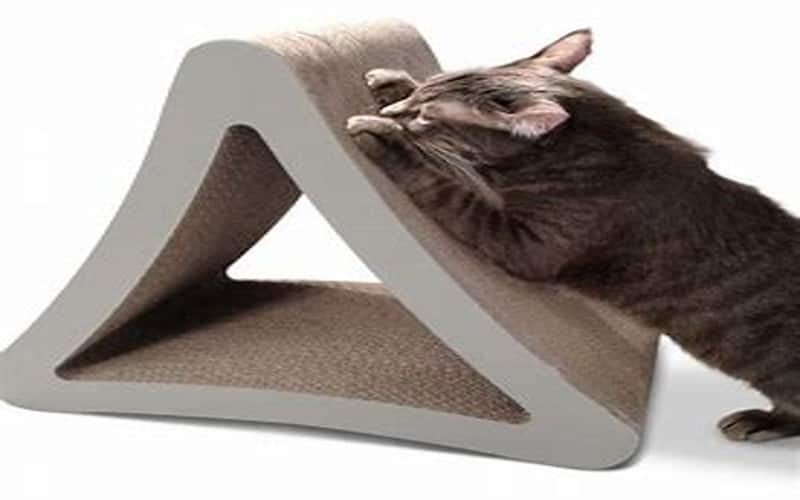How To Stop A Cat From Scratching The Door
Updated: 22 Aug 2024
266

A cat scratching The Door is it true? Yes, Cats are beloved companions, but their natural scratching behavior can sometimes lead to damaged doors and frustrated owners. If you’ve found yourself wondering how to stop your cat from scratching the door, you’re not alone. This common feline behavior serves multiple purposes for cats, including marking territory, stretching muscles, and maintaining claw health. However, when directed at your doors, it can result in unsightly damage and disruption to your home’s peace.
From understanding the root causes of this behavior to implementing practical solutions, we’ll cover everything you need to know to maintain harmony between your feline friend and your home’s entryways.
Understanding Why Cats Scratch Doors

Cats are notorious for scratching various surfaces around the house, and doors are no exception. This behavior can be perplexing and even frustrating for cat owners, but understanding the reasons behind it can help in addressing the issue effectively. Let’s delve into why cats scratch doors and explore strategies to mitigate this behavior.
Whether you’re dealing with a persistent door scratcher or looking to prevent the behavior before it starts, our expert tips and techniques will help you create a cat-friendly environment while preserving your doors’ integrity.
Natural Instincts and Behaviors

“There are some reasons for “A cat scratching The Door”.
1-Territorial Marking
One of the primary reasons cats scratch doors is to mark their territory. Cats have scent glands in their paws, and by scratching, they deposit pheromones onto surfaces, leaving their scent behind. This behavior is particularly prevalent in multi-cat households where each cat needs to establish its territory. Doors, being a prominent and frequently touched surface, become a prime target for this territorial marking.
2-Attention-Seeking Behavior
Another common reason for door scratching is attention-seeking. Cats are intelligent creatures and quickly learn that scratching doors can elicit a response from their owners. If a cat scratches a door and receives attention, whether it’s a reprimand or an attempt to calm them down, the behavior is reinforced. Over time, this can become a habitual way for cats to demand attention or interaction from their humans.
3-Stress and Anxiety
Stress and anxiety can also contribute to door scratching. Cats are sensitive animals, and changes in their environment, such as new furniture, visitors, or changes in routine, can cause them to scratch doors as a coping mechanism. Scratching provides a sense of comfort and helps them deal with their anxiety by providing an outlet for their stress.
Environmental Factors(To stop a cat scratching the door)
There are some environmental factors that help to understand, “How to stop a cat from scratching the door?
1-Separation Anxiety
Separation anxiety is another factor that can lead to door scratching. When cats are left alone, they may experience anxiety and become distressed. Scratching at doors is a way for them to express their discomfort and attempt to escape from their perceived isolation. This behavior is often observed in cats who have a strong bond with their owners and struggle with being alone.
2- Outdoor Stimuli
Outdoor stimuli can also play a role in door scratching. Cats are naturally curious and may scratch at doors to get closer to the sights and sounds outside. If a cat hears or sees something interesting through the door, they may scratch in an attempt to investigate or reach the source of their curiosity.
Effective Strategies to Stop Door Scratching
Addressing door scratching requires a multifaceted approach. Here are some effective strategies to help deter “How to stop a cat from scratching the door?
Provide Alternative Scratching Surfaces Or Selecting the Right Scratching Posts

One of the most effective ways to stop door scratching is to provide your cat with appropriate scratching surfaces. Scratching posts come in various materials, such as sisal, carpet, and cardboard. It’s essential to choose a scratching post that appeals to your cat’s preferences. For instance, some cats prefer vertical posts, while others may favor horizontal surfaces. Observing your cat’s scratching habits can help you select the right type of scratching post.
Optimal Placement of Scratching Areas
The placement of scratching posts is also crucial. Position them near the areas where your cat commonly scratches or near their favorite resting spots. By providing scratching posts in strategic locations, you can encourage your cat to use them instead of the doors. Additionally, placing a scratching post near a door that your cat frequently scratches can help redirect their attention.
Deterrents and Barriers

Double-Sided Tape and Protective Sheets
Using deterrents can be an effective way to discourage door scratching. Double-sided tape applied to the door’s surface can be an effective deterrent. Cats dislike the sticky texture, and the unpleasant sensation can discourage them from scratching. Additionally, protective sheets or covers specifically designed to prevent scratching can be attached to doors.
Scent-Based Deterrents
Scent-based deterrents can also help in stopping door scratching. Cats are sensitive to strong smells, and using scents that they find unpleasant, such as citrus or vinegar, can deter them from scratching. You can use commercially available cat deterrent sprays or create your own solution by mixing water with essential oils or vinegar.
Physical Barriers
Physical barriers can be employed to prevent access to doors. For instance, using a door scratch guard or placing a barrier, such as a piece of furniture or a large object, in front of the door can help keep your cat away from the scratching area.
Positive Reinforcement Techniques
Rewarding Good Behavior
Positive reinforcement is a powerful tool in modifying behavior. Whenever your cat uses the scratching post or exhibits desired behavior, reward them with treats, praise, or playtime. This positive reinforcement helps reinforce the behavior you want to see and makes it more likely that your cat will use the scratching post instead of the door.
Clicker Training for Redirecting Scratching
Clicker training is another effective technique for redirecting scratching behavior. Using a clicker, you can train your cat to associate the sound with positive rewards. When your cat scratches the designated scratching post instead of the door, use the clicker and provide a treat. Over time, your cat will learn that scratching the post yields rewards, making it a more appealing option than scratching the door.
Addressing Underlying Issues
Reducing Stress and Anxiety and Creating a Calm Environment
Reducing stress and anxiety is crucial in addressing door scratching. Creating a calm and stable environment can help your cat feel more secure and reduce the urge to scratch doors as a coping mechanism. Ensure that your cat has a comfortable and quiet space where they can retreat and feel safe.
- Pheromone Products and Their Benefits
Pheromone products can also be beneficial in reducing stress and anxiety. These products, such as diffusers or sprays, mimic the natural pheromones that cats produce to mark their territory and create a sense of security. By using pheromone products, you can help your cat feel more relaxed and less inclined to scratch doors.
- Interactive Toys and Playtime
Enriching your cat’s environment with interactive toys and regular playtime can help alleviate boredom and reduce stress. Engaging your cat in stimulating activities can provide an outlet for their energy and reduce the likelihood of scratching doors. Toys that encourage hunting and play, such as feather wands and puzzle toys, can keep your cat entertained and mentally stimulated.
- Window Perches and Viewing Areas
Providing window perches or viewing areas can also help satisfy your cat’s curiosity and reduce door scratching. By giving your cat a vantage point to observe the outside world, you can keep them entertained and less likely to scratch at doors to investigate outdoor stimuli.
- Protective Measures for Doors
To protect your doors from scratching damage, consider using door covers or shields. These protective measures are designed to safeguard the door’s surface while still allowing easy access. They can be easily installed and removed, making them a practical solution for preventing scratches.
- Scratch-Resistant Paint and Finishes
Applying scratch-resistant paint or finishes to your doors can help maintain their integrity. These specialized coatings are designed to withstand wear and tear, including scratching. By investing in scratch-resistant treatments, you can prolong the life of your doors and minimize the visible effects of scratching. Avoid “A cat scratching The Door”.
- Regular Nail Maintenance and Proper Trimming Techniques(To stop a cat scratching the door)
Regular nail maintenance is essential for minimizing scratching damage. Keeping your cat’s claws trimmed can reduce the impact of scratching and make it less likely to cause damage. Use proper trimming techniques and nail clippers designed for cats to ensure a safe and effective trimming process.
- Soft Paws and Other Claw Caps
Soft Paws or other claw caps can be used to cover your cat’s claws and prevent scratching damage. These soft, rubbery caps are applied to your cat’s claws and help protect surfaces from being scratched. They are a non-invasive solution that can be effective in reducing scratching behavior.
When to Seek Professional Help or Consulting a Veterinarian for Ruling Out Medical Issues
If door scratching persists despite your best efforts, it may be time to consult a veterinarian. In some cases, scratching behavior can be a sign of underlying medical issues, such as skin conditions or discomfort. A thorough examination can help rule out any health problems that may be contributing to the behavior.
- Behavioral Modification Medications
In certain cases, behavioral modification medications may be recommended by a veterinarian. These medications can help manage anxiety or stress-related behaviors and can be used in conjunction with behavioral modification techniques to address door scratching.
- Working with a Feline Behaviorist(To stop a cat scratching the door)
A feline behaviorist can provide valuable insights and customized behavior modification plans to address door scratching. These professionals specialize in understanding and modifying feline behavior and can create a tailored approach based on your cat’s specific needs.
- Long-Term Strategies for Success
Working with a behaviorist can help ensure long-term success in managing door scratching. They can provide ongoing support, monitor progress, and adjust strategies as needed to achieve lasting results and improve your cat’s behavior.
Conclusion
Stopping your cat from scratching doors requires patience, understanding, and a multi-faceted approach. By implementing the strategies outlined in this guide, you can effectively redirect your cat’s scratching behavior while maintaining a harmonious household. Remember that each cat is unique, and what works for one may not work for another. Be prepared to experiment with different techniques and remain consistent in your efforts.
With time and dedication, you can successfully train your cat to scratch appropriate surfaces and leave your doors intact. Always prioritize your cat’s well-being and natural instincts while addressing unwanted behaviors. By creating a stimulating environment, providing alternatives, and using positive reinforcement, you’ll not only protect your doors but also strengthen the bond with your feline companion. If challenges persist, don’t hesitate to seek professional help from veterinarians or feline behaviorists who can offer tailored solutions for your specific situation.
What’s an effective way to deter a cat from scratching the door without harming them?
Apply double-sided tape to the door where the cat typically scratches. Cats dislike the sticky sensation on their paws, which will discourage the behavior. Additionally, provide an appropriate scratching post nearby as an alternative. This redirects their natural scratching instinct to an acceptable location.
How can I train my cat to stop scratching the door?
Training involves redirecting your cat’s scratching behavior. When you catch your cat scratching the door, gently move them to their scratching post and reward them with treats or affection when they use it. Consistency and patience are key.
What can I do to provide a better scratching outlet for my cat?
Provide your cat with a variety of scratching posts or pads placed near their favorite scratching spots. Different materials (e.g., sisal, cardboard) and orientations (vertical, horizontal) can cater to their preferences. Regularly encouraging your cat to use these posts with treats and praise can also help.
How can I make the door less appealing to my cat?
You can make the door less appealing by using deterrents like double-sided tape, aluminum foil, or commercial pet repellents. Cats dislike the sticky or crinkly texture, which can discourage them from scratching the door.
Why does my cat scratch the door?
Cats scratch doors for several reasons: to mark their territory, to sharpen their claws, to stretch their muscles, or because they’re feeling bored or anxious. Understanding the underlying reason can help you address the behavior more effectively.
Please Write Your Comments